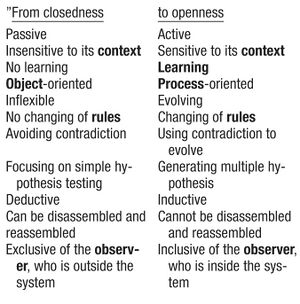OPENNESS
Appearance
Charles François (2004). OPENNESS, International Encyclopedia of Systems and Cybernetics, 2(2): 2350.
| Collection | International Encyclopedia of Systems and Cybernetics |
|---|---|
| Year | 2004 |
| Vol. (num.) | 2(2) |
| ID | ◀ 2350 ▶ |
| Object type | Methodology or model |

The more or less free flow of matter and energy from the environment into the system and vice-versa.
A. COLLEN et al (l994, p.65-68) make the following relevant points: “Most concrete systems have boundaries which are at least partially permeable, permitting sizable magnitudes of at least certain sorts of matter-energy or information transmission to cross them. Such a system is an open system (in which) entropy may increase, remaining in steady state or decrease. The classical notion of openness can be named the thermodynamic one…
- “A system can be opening or closing, which emphasizes the processes of the system.
- “With respect to the hierarchy a system can be open or closed at different levels…”
The authors distinguish various types of openness: passive or active; tactic or strategic, and establish a table comparing closedness to openness, as follows: